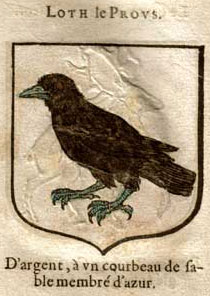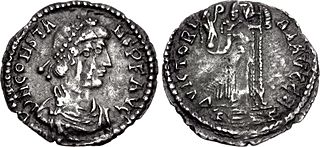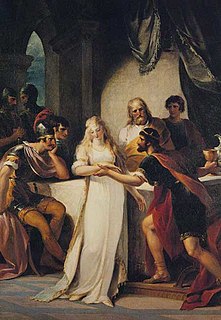Related Research Articles

Magnus Maximus was Roman emperor in the western portion of the Empire from 383 to 388. He usurped the throne from emperor Gratian in 383, through negotiation with emperor Theodosius I.
Geoffrey of Monmouth was a British cleric, anthropologist and one of the major figures in the development of British historiography and the popularity of tales of King Arthur. He is best known for his chronicle The History of the Kings of Britain which was widely popular in its day, being translated into other languages from its original Latin. It was given historical credence well into the 16th century, but is now considered historically unreliable.

Uther Pendragon, also known as King Uther, is a legendary king of sub-Roman Britain and the father of King Arthur. A few minor references to Uther appear in Old Welsh poems, but his biography was first written down by Geoffrey of Monmouth in his Historia Regum Britanniae, and Geoffrey's account of the character was used in most later versions. He is a fairly ambiguous individual throughout the literature, but is described as a strong king and a defender of his people.

Coel, also called Coel Hen, is a figure prominent in Welsh literature and legend since the Middle Ages. Early Welsh tradition knew of a Coel Hen, a c. 4th-century leader in Roman or Sub-Roman Britain and the progenitor of several kingly lines in Yr Hen Ogledd, the Brittonic-speaking part of what is now northern England and southern Scotland.
Beli Mawr was an ancestor figure in Middle Welsh literature and genealogies. He is the father of Cassivellaunus, Arianrhod, Lludd Llaw Eraint, Llefelys, and Afallach. In certain medieval genealogies he is listed as the son or husband of Anna, cousin of Mary, mother of Jesus. According to the Welsh Triads, Beli and Dôn were the parents of Arianrhod, but the mother of Beli's other children—and the father of Dôn's other children—is not mentioned in the medieval Welsh literature. Several royal lines in medieval Wales traced their ancestry to Beli. The Mabinogi names Penarddun as a daughter of Beli Mawr, but the genealogy is confused; it is possible she was meant to be his sister rather than daughter.

Cunobeline was a king in pre-Roman Britain from about AD 9 until about AD 40. He is mentioned in passing by the classical historians Suetonius and Dio Cassius, and many coins bearing his inscription have been found. He controlled a substantial portion of south-eastern Britain, including the territories of the Catuvellauni and the Trinovantes, and is called "King of the Britons" by Suetonius. He appears to have been recognized by Roman emperor Augustus as a client king, as testified by the use of the Latin title Rex on his coins. Cunobeline appears in British legend as Cynfelyn (Welsh), Kymbelinus or Cymbeline, as in the play by William Shakespeare.

Lot, Loth or Lothus is the king of Lothian, the realm of the Picts in the Arthurian legend. Such a ruler first appeared late in the 1st millennium's hagiographical material concerning Saint Kentigern, which feature a Leudonus, king of Leudonia, a Latin name for Lothian. In the 12th century, Geoffrey of Monmouth adapted this to Lot, king of Lothian, in his influential chronicle Historia Regum Britanniae, portraying him as King Arthur's brother-in-law and ally. In the wake of Geoffrey's writings, Lot appeared regularly in later works of chivalric romance.

Tasciovanus was a historical king of the Catuvellauni tribe before the Roman conquest of Britain.
Queen Gwendolen, also known as Gwendolin, or Gwendolyn was a legendary ruler of ancient Britain. She is said to have been queen during the 11th century BC.

Historia regum Britanniae, originally called De gestis Britonum, is a pseudohistorical account of British history, written around 1136 by Geoffrey of Monmouth. It chronicles the lives of the kings of the Britons over the course of two thousand years, beginning with the Trojans founding the British nation and continuing until the Anglo-Saxons assumed control of much of Britain around the 7th century. It is one of the central pieces of the Matter of Britain.
Arvirargus was a legendary, and possibly historical, British king of the 1st century AD. A shadowy historical Arviragus is known only from a cryptic reference in a satirical poem by Juvenal, in which a giant turbot presented to the Roman emperor Domitian is said to be an omen that "you will capture some king, or Arviragus will fall from his British chariot-pole".
Marius was a legendary king of the Britons during the time of the Roman occupation of Britain, as recounted in Geoffrey of Monmouth's pseudohistorical Historia Regum Britanniae. He was the son of King Arvirargus and ruled following his father's death.
Dionotus was a legendary king of Cornwall in Geoffrey of Monmouth's Historia regum Britanniae, an account of the rulers of Britain based on ancient Welsh sources and disputed by many historians. Dionotus succeeding his brother Caradocus, and was regent of Britain during the campaigns in Gaul of Emperor Magnus Maximus. The curious thing about this king is that the Welsh chronicles, which parallel most of Geoffrey of Monmouth's book, do not mention this king by name. However, Geoffrey uses Latin versions of Welsh names so he could be referring to Dynod, duke of Cornwall, or Anwn Dynod, Maximus's own son. The latter would probably be Conan Meriadoc another son of Caradoc of Cornwall.
Gracianus Municeps was a legendary King of the Britons, according to Geoffrey of Monmouth's Historia regum Britanniae, a largely fictional account of British history. After the death of Roman Emperor Magnus Maximus, Gracianus seized the throne of Britain upon receiving word of Maximus's demise, by whose orders he had been sent to defend the attacked island while Maximus was campaigning on the continent.

Constans II was the eldest son of the Western Roman Emperor Constantine III and was appointed co-emperor by him from 409 to 411. He was killed during the revolts and fighting that ended his father’s reign.
Conan Meriadoc is a legendary British leader credited with founding Brittany. Versions of his story circulated in both Brittany and Great Britain from at least the early 12th century, and supplanted earlier legends of Brittany's foundation. His story is known in two major versions, which appear in the Welsh text known as The Dream of Macsen Wledig, and in Geoffrey of Monmouth's Historia Regum Britanniae. Both texts associate him with Magnus Maximus, a Roman usurper against the Valentinianic dynasty who was widely regarded as having deprived Britain of its defences when he took its legions to claim the imperial throne. Conan's cousin or sister, Saint Elen, is said to have been Macsen Wledic's wife.
Guiderius is a legendary British king according to Geoffrey of Monmouth's Historia Regum Britanniae and related texts. He can probably be identified as deriving from the historical Togodumnus.
Hafren was a legendary British princess who was drowned in the River Severn by her repudiated stepmother Gwendolen. The legend appears in Geoffrey of Monmouth's pseudohistorical chronicle Historia Regum Britanniae. According to Geoffrey, Hafren is the eponym of the Severn, which bears one of Britain's most ancient river names.

Rowena in the Matter of Britain was the daughter of the mythological Anglo-Saxon chief Hengist and wife of Vortigern, "King of the Britons". Presented as a beautiful femme fatale, she won her people the Kingdom of Kent through her treacherous seduction of Vortigern. Contemporary sources do not mention Rowena, which leads modern historians to regard her as fictitious.

Gogmagog was a legendary giant in Welsh and later English mythology. According to Geoffrey of Monmouth's Historia Regum Britanniae, he was a giant inhabitant of Albion, thrown off a cliff during a wrestling match with Corineus. Gogmagog was the last of the Giants found by Brutus and his men inhabiting the land of Albion.
References
- ↑ Hall, Mathew (1854). Lives of the Queens of England Before the Norman Conquest. History of women. Harvard University: Blanchard and Lea. pp. 74.
- ↑ Geoffrey of Monmouth, Historia Regum Britanniae 4.15-16